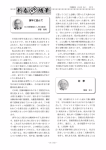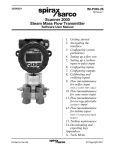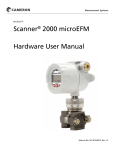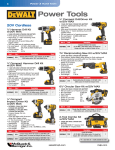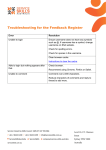Download SIR07 User Guide
Transcript
SIR07 User Guide Doing it RightII Industry requirements for implementing retail qualifications in the Retail Services Training Package (SIR07) Retail Services Training Package Training people well in the retail industry Foreword The retail industry needs highly skilled workers. This User Guide Doing it Right has been developed by Service Skills Australia and sets out industry views and expectations about the training and assessment requirements in the retail industry. It should be used in conjunction with the endorsed SIR07 Retail Services Training Package. This document is applicable to the retail qualifications in the Retail Services Training Package. A separate document exists for the Community Pharmacy qualifications in the Retail Services Training Package. It offers trainers and assessors easy access to a useful resource with information and practical strategies that will assist them in ensuring good practice in skills and knowledge development. It also sets out industry expectations that will inform policy makers and auditors. Industry also has its part to play in ensuring quality outcomes and effective skills development. It is the responsibility of industry to facilitate quality work placement and be pro-active in advising the trainers that deliver the training programs and develop staff. The key message from industry is: This is what we really need—and here are some tools—how can we all work together to achieve it? Ian Blandthorn, Chair WRAPS Industry Advisory Committee Service Skills Australia Contents Industry requirements . . . . . . . . . . . . . . . . . . . . . . . . . . . . . . . . . . . . . . . . . . . . . . . . . . . . . . . . . 1 Training driven by industry demand . . . . . . . . . . . . . . . . . . . . . . . . . . . . . . . . . . . . . . . . . . . . 2 Priority areas and skills shortages . . . . . . . . . . . . . . . . . . . . . . . . . . . . . . . . . . . . . . . . . . . . . . . . . . . . . 2 New entrants . . . . . . . . . . . . . . . . . . . . . . . . . . . . . . . . . . . . . . . . . . . . . . . . . . . . . . . . . . . . . . . . . . . . . . . . 2 Work ready graduates . . . . . . . . . . . . . . . . . . . . . . . . . . . . . . . . . . . . . . . . . . . . . . . . . . . . . . . . . 3 Developing an employable person . . . . . . . . . . . . . . . . . . . . . . . . . . . . . . . . . . . . . . . . . . . . . . . . . . . 3 Developing retail people from entry level through to management job roles . . . . . . . . . 3 Funding models are not delivery models . . . . . . . . . . . . . . . . . . . . . . . . . . . . . . . . . . . . . . . . . . . . . 4 Minimum learning and assessment hours . . . . . . . . . . . . . . . . . . . . . . . . . . . . . . . . . . . . . . . . . . . . 4 Registered training organisations with realistic programs and business models . . 5 Being realistic about what can be achieved . . . . . . . . . . . . . . . . . . . . . . . . . . . . . . . . . . . . . . . . . . .5 Selecting and training people who are suited to the job . . . . . . . . . . . . . . . . . . . . . . . . . . . . . . 5 Preferred delivery pathways . . . . . . . . . . . . . . . . . . . . . . . . . . . . . . . . . . . . . . . . . . . . . . . . . . . . . . . . . . 6 VET in schools . . . . . . . . . . . . . . . . . . . . . . . . . . . . . . . . . . . . . . . . . . . . . . . . . . . . . . . . . . . . . . . . . . . . . . . . 6 Existing workers . . . . . . . . . . . . . . . . . . . . . . . . . . . . . . . . . . . . . . . . . . . . . . . . . . . . . . . . . . . . . . . . . . . . . . 7 Innovation and responsiveness . . . . . . . . . . . . . . . . . . . . . . . . . . . . . . . . . . . . . . . . . . . . . . . . . . . . . . 7 Integrated and contextualised training and assessment practices . . . . . . . . . . . . . . . . 8 Integrated delivery . . . . . . . . . . . . . . . . . . . . . . . . . . . . . . . . . . . . . . . . . . . . . . . . . . . . . . . . . . . . . . . . . . . 8 On the job learning . . . . . . . . . . . . . . . . . . . . . . . . . . . . . . . . . . . . . . . . . . . . . . . . . . . . . . . . . . . . . . . . . . 9 Robust assessment of skills and knowledge . . . . . . . . . . . . . . . . . . . . . . . . . . . . . . . . . . . . 10 Specific training package requirements . . . . . . . . . . . . . . . . . . . . . . . . . . . . . . . . . . . . . . . . . . . . . 10 Job roles over ticks, flicks and atoms . . . . . . . . . . . . . . . . . . . . . . . . . . . . . . . . . . . . . . . . . . . . . . . . . 10 Knowledge and skills . . . . . . . . . . . . . . . . . . . . . . . . . . . . . . . . . . . . . . . . . . . . . . . . . . . . . . . . . . . . . . . . 10 Simulations as part of assessment . . . . . . . . . . . . . . . . . . . . . . . . . . . . . . . . . . . . . . . . . . . . . . . . . . . 10 Context of delivery and assessment . . . . . . . . . . . . . . . . . . . . . . . . . . . . . . . . . . . . . . . . . . . . . . . . . 11 Supporting integrated training delivery and assessment . . . . . . . . . . . . . . . . . . . . . . . . . . . . . 12 Qualified trainers and assessors . . . . . . . . . . . . . . . . . . . . . . . . . . . . . . . . . . . . . . . . . . . . . . . 14 AQTF 2007 Essential Standards for Registration . . . . . . . . . . . . . . . . . . . . . . . . . . . . . . . . . . . . . . 14 Additional retail industry requirements for trainers and assessors . . . . . . . . . . . . . . . . . . . . 15 Additional advice for SIR07 Retail Services Training Package users . . . . . . . . . . . . . . 16 Minimum learning and assessment hours . . . . . . . . . . . . . . . . . . . . . . . . . . . . . . . . . . . . . . . . . . . 16 Providing language literacy and numeracy support . . . . . . . . . . . . . . . . . . . . . . . . . . . . . . . . . 23 this page is intentionally blank Industry requirements This User Guide is a series of ‘good practice’ fact sheets. These information sheets identify and explain the key skills and knowledge development objectives for the retail industry. They also suggest tools and ideas to assist employers, registered training organisations (RTOs), assessors and trainers to work with the training package and develop industry ready graduates. The following topics are covered: • Training driven by industry demand • Work ready graduates • RTOs with realistic programs and business models • Selection and training of people suited to the job • Integrated and contextualised training and assessment practice • Robust assessment of skills and knowledge • Qualified trainers and assessors • Additional advice for SIR07 Retail Services Training Package users Over time, the suite of tools and resources available on the Service Skills Australia website will include more free sample tools and ideas that will enable RTOs to work with industry to develop quality training outcomes. Tools and resources For all tools and resources, go to www.serviceskills.com.au 1 Industry wants... Training driven by industry demand The retail industry values the retail qualifications in the SIR07 Retail Services Training Package and needs RTOs to focus on quality delivery of those qualifications so that the training plans match the jobs on offer. Priority areas and skills shortages At a fundamental level, the retail industry needs the people coming out of training to have skills that match the jobs on offer. Demand is more complex than a simple numbers game. It is about the right people with the right skills for the right jobs at the right time. It is as much about existing workers as it is about new entrants. It is about balancing present needs with future directions. There are large numbers of skilled and experienced existing workers who lack formal qualifications at all levels in the retail industry. As an area of small, medium and large business, the retail industry also needs supervisors, managers and employers with strong team leadership and business skills. RTOs are encouraged to offer supervision, business and retail management skills training via units in the Certificate SIR30207 III in Retail, SIR40207 Certificate IV in Retail Management and the SIR50207 Diploma Retail Management. New entrants The retail industry has long been a sector that provides the first experience of employment, with many people citing retail as their first job. For a large number of young people, retail is a part time, transient occupation while studying for a career in other areas. A significant number, however, go on to make a career in retail, progressing through the many areas that are covered by the industry. Retail industry employers are keen to engage with new industry entrants who have the life skills and attitudes that are suited to a customer service industry and then train them via a traineeship pathway. Ideal applicants to train for frontline retail positions are described as: • having done some research on the industry • having some experience in a customer service environment • able to demonstrate team skills through other employment, volunteering or sport • outgoing • having a good command of English and strong communication skills • having basic numeracy skills and • fit enough to cope with a job that is performed over long hours on their feet. 2 Industry wants... Work ready graduates All employers want people with great technical and customer service or sales skills, people who can think for themselves and solve problems while still following the key rules and procedures, people who can work quickly and efficiently—and of course, people who can keep learning and developing with the business. Developing an employable person It is industry’s view that employable people can only come from training and assessment that actually reflects the workplace. This requires: • Training and assessing in the appropriate physical environment (as per each unit of competency and the assessment guidelines). • Adequate up-to-date equipment and technology to reflect current industry practices. • Speed and timing for tasks typical for a commercial operation. • Productivity to reflect industry expectations. • Integration of multiple tasks and application of multiple competencies simultaneously. • Dealing with multiple and varied customers and team members. • Interruptions to work, which are typical of the workplace. • Dealing with multiple and varied problems in given timeframes. • Integration of health and safety issues, employability skills and compliance demands. • Sufficient customer traffic that accurately reflects the complexity of the role and allows candidates to deal with multiple tasks simultaneously. Developing retail people from entry level through to management job roles The suite of retail qualifications in the SIRO7 Retail Services Training Package have been carefully constructed to train work ready graduates for a range of key industry job roles. Whilst the core and elective structure of qualifications vary there are a broad range of complex skills that employers expect to see demonstrated by employable job applicants from Certificate II to Diploma. RTOs should work with industry to offer work-integrated and project-based learning that develops graduates who are ready for work. In order to meet retail industry requirements RTOs should ensure that graduates of each qualification are able to apply skills and knowledge gained to the level of complexity described in the employability skills summary for each qualification. These summaries may be found in the qualifications section of the SIR07 Retail Services Training Package. 3 Funding models are not delivery models Nominal training hours are allocated to individual units of competency in the purchasing, mapping or implementation guides which are developed by some state training authorities. Nominal hours are not always the same across states and territories. Some states use nominal hours to fund training. Industry has some particular views about nominal hours and their interpretation: • While acknowledging the implications of nominal hours for RTOs, the focus for employers is wholly on the training outcomes. • Industry takes the view that competency cannot be achieved without a holistic work integrated approach to learning and assessment, along with sufficient practice and workplace application— well outside the restrictions of nominal hours. • Attempting to achieve outcomes for institutional learners, without effective work integration strategies and the proper allocation of time, is clearly not achievable. The retail industry will actively support RTOs who develop innovative ways of addressing resource challenges in order to achieve quality industry relevant outcomes. Industry also strongly believes that an RTO should only offer programs where it can successfully meet those challenges—both for the sake of individual students and for the industry more broadly. Minimum learning and assessment hours Minimum learning and assessment hours as defined by the retail industry are not related to course funding. They are an industry minimum based on a composite of structured (or formal) learning and assessment plus workplace integration of skills and knowledge. This composite figure includes nominal hours allocated to units of competency in state or territory implementation, purchasing or mapping guides plus the additional recognition of the time taken to integrate retail skills and knowledge in a workplace context. Retail industry expectations regarding minimum learning and assessment hours for all units in the retail qualifications SIR07 Retail Services Training Package are set out in the section headed Additional advice for SIR07 Retail Services Training Package Users at the rear of this guide. 4 Industry wants... Registered training organisations with realistic programs and business models Being realistic about what can be achieved Achieving quality outcomes from any training depends on everyone making an honest and realistic assessment of what can be achieved in a given set of circumstances. • Some employers may not be able to provide the required range of experience for an individual undertaking a particular retail qualification—arrangements need to be put in place to address this. • An RTO may not have the required resources (or external access to required resources) to support delivery of particular qualifications. Resources might include high cost retail technology, an adequate supply of teachers with current and relevant experience or access to retail workplaces. Selecting and training people who are suited to the job RTOs and others in the training system have an obligation to enrol individuals in programs where they expect successful outcomes and have a real chance of employment. While ‘pre-training’ evaluation of what a person will achieve after training is unfair, quality RTOs have always had tools to select appropriate students. There is an industry expectation that the training system will: • provide appropriate counselling to prospective students to guide them towards programs that maximise their chances of success • have in place a range of customised selection tools and processes that reflect the needs of particular industry sectors and • provide an accurate picture of the industry and its working conditions to assist potential students make informed choices. The retail industry believes effective selection processes will mean that RTOs are more likely to enrol students: • In a way that recognises the diversity of industry roles. For example: the pre-existing art and design aptitudes and skills needed by a visual merchandiser are quite different to those required by a customer service operator. • With the general attributes and attitudes needed to work in customer service. For example: interpersonal communication skills for frontline service roles. • In the appropriate level of qualification, in particular acknowledging when students might not be ready to undertake ‘higher-level’ qualifications. • With the requisite life or work experience and / or maturity (not always related to age) to take on the particular role reflected in the qualification. For example: a retail manager responsible for leading teams. There is no point in enrolling a student with a part time job as a sales assistant in a retail management qualification. • With the required level of language and literacy skills, not just to do the job, but also to undertake the required learning. Tools Go to www.serviceskills.com.au to download a range of good practice selection tools. 5 Preferred delivery pathways The competencies in this training package may be attained in a number of ways including through: • formal or informal education and training • experiences in the workplace • general life experience or • any combination of the above. Assessment under this training package leading to an AQF qualification or Statement of Attainment may follow a learning and assessment pathway, an assessment‑only or recognition pathway, or a combination of the two as illustrated in the following diagram from the SIR07 Retail Services Training Package. Learning and assessment pathways Units of and/or competency Assessment only or recognition of prior learning pathways Statement of Attainment and/ or qualification under the Australian Qualifications Framework Statement of Attainment and/ or qualification under the Australian Qualifications Framework Each of these assessment pathways leads to full recognition of competencies held – the critical issue is that the candidate is competent, not how the competency was acquired. The retail industry strongly supports the formative development of skills via work integrated learning. Certificates II and III in Retail are preferred via a traditional traineeship model which combines off and on the job delivery. For visual merchandisers, most training is in a pre-employment context, however, quality providers integrate significant on the job retail visual merchandising experience, via work placements at different intervals throughout the diploma. Management qualifications are best gained by project based approaches to real workplace management experiences. The retail industry has a clear expectation that learners in institutional programs are provided with access to workplace experience directly related to the skills contained in the qualification for which they are studying. VET in schools Supporting school students to achieve vocational skills In some industries, Certificate I and Certificate II qualifications are regarded as ‘pathway’ qualifications or as preparatory study—and all stakeholders accept that those qualifications do not reflect particular job outcomes. The SIR10107 Certificate I in Retail is a pre-employment qualification. 6 The SIR20207 Certificate II in Retail has been recognised as suitable for an Australian Apprenticeship pathway with real work outcomes, and is appropriate for VET in Schools delivery. This qualification provides the skills and knowledge for an individual to be competent in a range of activities and functions requiring basic retail operational knowledge and limited practical skills in a defined context. Work would be undertaken in various retail store settings, such as specialty stores, supermarkets, department stores and retail fast food outlets. Individuals may work with some autonomy or in a team but usually under close supervision. The retail industry strongly encourages any school considering the delivery of the Certificate II in Retail to carefully assess its planning and resource capacity to provide quality work integrated learning experiences that will achieve the outcomes industry needs. Existing workers For many years and across multiple sectors, the retail industry has needed a greater focus on skills development and recognition for existing workers. There are two key imperatives: • Much more effective Recognition of Prior Learning (RPL), so that experienced workers are able to: - Achieve qualifications when they already have the skills. - Identify gaps and opportunities to gain new skills. • Effective existing worker training for a whole range of skills that are a priority for the industry’s prosperity. Both of these call for creative, innovative approaches by RTOs, that move beyond the way that training for retail has traditionally been provided. Innovation and responsiveness Technologies change, new markets emerge, different business models are created. Anecdotes abound about the inability of training to keep up with current industry practice. This represents a real challenge for RTOs and needs constant monitoring. Some of the things that industry considers vital in achieving quality outcomes are: • Effective integration of-off-the job learning with on-the-job learning and experience. • An ability and willingness to adjust programs quickly, and have the systems in place to support this. For example, frequent systemic checks for currency and ongoing professional development for trainers and assessors that is retail specific. • Innovative ways of providing student access to the latest retail technologies. • Regular and frequent updating of resources used to support training. • Regular contact with and involvement in the activities of the key industry associations that are able to provide ‘on-the-ground’ intelligence about changing trends and needs. Perhaps most importantly, industry wants to feel confident that the training system has clear and current data about what is needed, and that it can respond to those needs quickly and creatively. Tools Go to www.serviceskills.com.au to download: • RTO Self Assessment Checklist: how responsive are we to industry demand • Industry Association Contact List 7 Industry wants... Integrated and contextualised training and assessment practices When developing delivery and assessment strategies for retail units of competency leading to qualifications, RTOs must refer to the Assessment Guidelines of the SIR07 Retail Services Training Package for guidance on an appropriate delivery and assessment environment. Integrated delivery The retail industry supports the integrated delivery and assessment of units of competency as this reflects real work practices. An integrated delivery approach brings together a number of units of competency that reflect actual workplace requirements. For example, an employee working in a retail workplace would complete a number of interrelated customer service, administration and technical tasks together, not simply one individual task at a time or in a set sequence. Integrating the development of skills and knowledge with their application in the workplace requires a structured approach that encourages students to participate in and actively contribute to their own learning. An integrated assessment activity would be designed to collect evidence for a number of units together, rather than designing one assessment activity for each individual unit, or for individual elements and performance criteria. Tools Go to www.serviceskills.com.au to download sample integrated delivery tools. 8 On the job learning Where an RTO conducts all or part of its delivery in an industry setting, the RTO must also ensure that all stated criteria are met in order to satisfy the assessment requirements of the training package. RTOs should be aware of state/territory legislative requirements and their own responsibilities under the AQTF when trainees undertake structured learning in the workplace. Placing Institutional Learners with Host Employers RTOs should also be aware of state/territory legislative requirements and their own responsibilities when placing institutional learners with host retail industry employers for the purpose of training. For example, a full time Diploma of Visual Merchandising student may be placed with a host employer as part of a training program. RTOs should always provide retail business owners/managers with support material to assist in structured, demonstrable training for the learner. Host employers should be aware of the performance already achieved by the learner and their level of proficiency. Employers and host employers should also be aware of the RTO expectations regarding the type of in store tasks a learner would be undertaking as part of their training. It is recognised that learners placed in retail stores as part of their training benefit most when: • the skills to be learned are clearly specified and agreed to in writing and • a workplace supervisor is assigned to guide and oversee learners’ progress. For each placement RTOs: • Should provide employers and host employers with an indication of the level of expertise of the learner and the specific performance outcomes that are expected from the store training. • Must also provide learners with a clear understanding of the on-the-job training they will receive and the expectations of the host employer and the RTO. • Should be able to provide evidence of a sample work placement tool which maps the formative development of skills over a number of placements integrating on and off job delivery and the formative and summative assessment of all units required to achieve the particular qualification as expressed in the SIR07 Retail Services Training Package. • Review the plan regularly in conjunction with the placement business and the learner to determine the learner’s progress and to identify any issues which may impact on successful delivery of the qualification. Tools Go to www.serviceskills.com.au to download online tools for planning and recording structured onthe-job learning and work placements. 9 Industry wants... Robust assessment of skills and knowledge Specific training package requirements The retail industry requirements for quality assessment are now much more clearly articulated in the SIR07 Retail Services Training Package—both in individual units of competency and in the assessment guidelines. RTOs must adhere to these requirements. Below is a summary of key points that reflect industry’s priorities. Job roles over ticks, flicks and atoms • The retail industry believes that quality assessment relies on qualified assessors making professional judgments about the ability of an individual to undertake a job role. • From an industry perspective, this approach is much more effective than assessment processes which place too much focus on checklists and specified quantities of evidence for individual elements or performance criteria. Knowledge and skills • ‘Old-style’ chalk and talk training with a focus on written tests to assess knowledge does not meet industry requirements for competent work ready graduates • Assessment that focuses only on just what you can see a person do is also not appropriate—for example, assessment checklists that only include elements and performance criteria do not support effective assessment • A key component of competency is knowledge—understanding why it is important to wash your hands when handling food, or the reason why there is a need to rotate stock, makes for more valuable employees • Units of competency provide clear guidance on the scope and depth of skills and knowledge required to achieve competency (how much detail about legislation does a frontline employee need, what sorts of problems should they be able to solve without help)—and these must be integrated to reflect the reality of the workplace. Simulations as part of assessment The retail industry places a premium on skills and knowledge that can be demonstrated in a real workplace environment. While assessment of some of the units of competency in SIR07 Retail Services Training Package can be carried out in a simulated work environment, the industry strongly recommends that assessment is conducted in the workplace, wherever possible. Assessment of competency requires the collection of evidence and this should be conducted over a period of time. This assessment approach may include demonstration at the workplace and/or a simulated work environment to ensure that the demonstration of competency is valid and reliable. The individual being assessed needs to be aware that the collection of evidence is ongoing and must be part of the planning, conduct and review of the assessment process. 10 Context of delivery and assessment All units identify resource requirements appropriate to the unit, including reference to ‘a real or simulated work environment’. This is defined as an environment that simulates the real workplace in its function and operation and provides access to a broad range of customers and relevant products. This includes adherence to retail policies, procedures and a range of stock and equipment. A simulated work environment may be required for the following reasons: • the learner may not have access to a workplace • the workplace may not use the relevant skill, equipment or process • conducting assessments may be disruptive or interfere with work • requirements, e.g. there may be ethical, privacy or confidentiality issues to consider; or • it may not be appropriate to apply the skills in the workplace due to potential risks to such things as health and safety, or to equipment being damaged. In order to be valid and reliable, the simulation must closely resemble what occurs in a real work environment. The simulated work environment should involve a range of activities that reflect real work experience. It is critical that when a simulated work environment is being set up, the assessor is thoroughly familiar with the competency standard as well as experienced in the current circumstances and environment of the workplace. In deciding whether a simulation or an assessment environment has been adequately set up, the following criteria must be applied where relevant to the requirements of the unit being assessed: • Provide access to the full range of up‑to‑date equipment and software that would generally be available in a modern retail or wholesale workplace. • Stock a comprehensive product range that will support the development and demonstration of the full range of skills and knowledge described in SIR07 Retail Services Training Package. • Provide sufficient customer traffic that accurately reflects the complexity of the role and allows candidates to deal with multiple retail services tasks simultaneously. • Require that candidates perform sales, services or tasks within timeframes that reflect accepted industry service times. • Involve candidates in prioritising competing tasks. • Allow candidates to deal with customers, including difficult ones. • Require candidates to work with others in a simulated team, which would typically include sales assistants or other retail services operational staff, supervisors and managers. 11 Supporting integrated training delivery and assessment As a general principle, the retail services industry supports the integration of units of competency for assessment, where practical, as this reflects real work practices. An integrated approach to assessment brings together a number of units of competency which reflect actual workplace requirements. For example, an employee working in a retail office would complete a number of interrelated clerical and administrative tasks together, not simply one individual task at a time. An integrated assessment activity would be designed to collect evidence for a number of units together rather than designing one assessment activity for each individual element of performance criteria. Where both training and assessment are required, the industry supports an approach which provides for off‑the‑job training combined with assessment of the application of skills and knowledge in a real work situation. The Retail Services Training Package defines on‑the‑job assessment as that assessment which occurs in the workplace as part of the normal operation of the business. The Retail Services Training Package defines off‑the‑job assessment as that which occurs away from the normal operation of the business, including, for example, assessment which may occur in the workplace but not under normal industry working conditions. The industry considers it important that candidates should have the opportunity to develop competency in structured learning programs, which includes assessing in the workplace whenever possible. Where an integrated competency assessment approach is implemented at Certificate II and above, it would be expected that several integrated competency assessments would be necessary to cover the breadth and complexity of the qualification. The context of the assessment, the role of the candidate and the complexity of the task will influence how many units of competency will be integrated. Following is an example of integrated competency assessment within the training package building on the concepts outlined above. Within each qualification, there are units of competency which are interrelated and which a candidate would naturally complete as part of their job function. For example, units: SIRXICT001A Operate retail equipment SIRXCCS001A Apply point‑of‑sale handling procedures, and SIRXCCS002A Interact with customers would mostly occur together. Therefore, evidence collected for one unit may cover all or some of another unit. The following scenario shows how an assessor undertook an observation of a candidate in the workplace interacting with a customer, operating a computer to check stock availability and price, and completing a sale. The workplace observation was the basis for the assessment and was supported by third-party reports and additional observations over a period of time. The assessor used a checklist to identify the critical aspects of evidence which was completed during the assessment activity. 12 SCENARIO The candidate greeted the customer with a smile and in accordance with store policy. The candidate then inquired as to the needs of the customer, and if she could be of any assistance. The candidate used appropriate questioning and active listening to establish the needs of the customer. The candidate communicated relevant information to the customer in a courteous and pleasant manner. The customer expressed interest in a particular item, but indicated that she was not happy with the colour. The candidate informed the customer that the other colours had been so popular that they were short on stock, but she would be happy to check their system to see if they had any left in the stock room. Using the store computer system, the candidate identified the correct code, and determined the number of items bought and any remaining stock that had not yet been put on the shop floor. She identified that they did have one left in stock and that it was the correct colour. The candidate then found the relevant item and scanned it into the system using the electronic bar coding equipment for price labelling. She then entered transaction information into the point of sale system using a scanner and politely informed the customer of the cost of the item. The customer tendered a debit card and the candidate processed the transaction using the EFTPOS terminal. The candidate completed the transaction after asking the customer to enter their PIN number. The candidate packed the item in a suitable bag and informed the customer that the receipt was in the bag. The candidate then thanked the customer and said goodbye in a friendly manner. This example highlights how units of competency can be grouped together and evidence collected for all three during the one assessment activity. It is important that the assessor clearly identifies units of competency that can be grouped together to ensure an efficient and effective assessment process. Units of competency can be grouped together in a number of ways and how this is achieved will depend on the relevant units and the job function of the candidate. 13 Industry wants... Qualified trainers and assessors AQTF 2007 Essential Standards for Registration The Australian Quality Training Framework 2007 Essential Standards for Registration specify the requirements to be met by RTOs throughout their period of registration. The National Quality Council is responsible for determining the training and assessment competencies to be held by trainers and assessors in accordance with Element 1.4 of the standards. All trainers and assessors of the SIR07 Retail Training Package must meet the requirements of Standard 1.4 as determined by the National Quality Council on 29 March 2007. Tools In order to access the current determination of the National Quality Council relating to the qualifications of trainers and assessors go to www.training.gov.au and follow the links to download the User’s Guide to the Essential Standards for Registration. 14 Additional retail industry requirements for trainers and assessors The following extract from the SIR07 Retail Services Training Package outlines industry requirements for assessors. “To satisfy the requirements of the AQTF, in addition to the mandatory units of competency in assessment, assessors must have the relevant vocational competencies they are assessing. For the retail services industry, vocational competence means that assessors have recent, relevant industry experience to fully understand a range of workplace requirements and apply them to assessment. Assessors (or at least one person in the assessment team) must satisfy the following requirements to meet industry expectations of vocational competence: a) Demonstrate current knowledge and experience of the industry, industry practices, and the job or role against which performance is being assessed. This may be demonstrated through at least one of the following: • actual workplace experience within the last two years • attendance at professional development or training and education activities focusing on good practice in the relevant industry competencies • participation in professional or industry networks. b) c) d) Demonstrate current knowledge and skill in assessing against this training package in a range of contexts. This may be demonstrated through at least one of the following: • familiarity with the units of competency in this training package to be used by the learner as a basis of assessment • recent planning, conduct and review of assessment and/or workplace training activities in a retail context • participation in moderation or validation processes and • attendance at professional development activities focused on assessment and/or workplace training. Demonstrate the necessary interpersonal and communication skills required in the assessment process. This may be demonstrated through evidence of one or more of the following: • attendance in professional development and/or training activities focused on effective communication in assessment and/or workplace training contexts • knowledge of language, literacy and numeracy issues in the context of assessment and workplace training and • recent assessment and/or workplace training activities. All assessors who are engaged in assessing against this training package must be either: • employed by an RTO, or • acting in partnership with an RTO where the assessor is working in an enterprise with a partnership arrangement with a private or public RTO. This training package provides a range of options for meeting these assessor requirements. Assessments can be undertaken in a variety of workplace and institutional contexts by individual assessors, partnerships involving assessors and technical experts, and teams of assessors.” 15 Additional advice for SIR07 Retail Services Training Package users Minimum learning and assessment hours Minimum learning and assessment hours as defined by the retail industry are not related to course funding. They are an industry minimum based on a composite of structured (or formal) learning and assessment plus workplace integration of skills and knowledge. This composite figure includes nominal hours allocated to units of competency in state or territory implementation, purchasing or mapping guides plus the additional recognition of the time taken to integrate retail skills and knowledge in a workplace context. Retail units The following table sets out the retail units in the SIR07 Retail Services Training Package and their retail industry recommended minimum learning and assessment hours. Code Unit title Minimum learning and assessment hours Retail units 16 SIRRFSA001A Apply retail food safety practices 40 SIRRFSA002A Monitor food safety program 35 SIRRIND001A Work effectively as a visual merchandiser 30 SIRRMER001A Merchandise food products 25 SIRRMER002A Pack and display meat products 25 SIRRMER003A Prepare and display fast food items 25 SIRRMER004A Prepare and display bakery products 25 SIRRMER005A Produce retail visual illustrations 30 SIRRMER006A Manufacture visual merchandising support structures 30 SIRRMER007A Apply lettering 70 SIRRMER008A Produce working drawings 45 SIRRMER009A Produce perspective drawings, plans and elevations 45 SIRRMER010A Design, construct and maintain props and merchandisers 45 SIRRMER011A Develop concept visuals 45 SIRRMER012A Maintain display lighting and brief lighting designers 60 SIRRMER013A Design and produce store plans and floor layouts 90 SIRRMER014A Manage visual merchandising projects 32 SIRRMER015A Design merchandisers 60 SIRRMER016A Style merchandise for photography 45 SIRRMER017A Design and produce merchandising and in-store presentations 90 Code Unit title SIRRMER018A Develop and apply strategies for merchandising and corporate presentation 80 SIRRMER019A Present design concepts 25 SIRRMER020A Create and implement exhibition space 80 SIRRRPK001A Advise on food products and services 24 SIRRRPK002A Advise on meat products 20 SIRRRPK003A Advise on fast food products 20 SIRRRPK004A Advise on bakery products 20 SIRRRPK005A Advise on seafood products 20 SIRRRPK006A Recommend liquor products 35 SIRRRPK007A Recommend and fit clothing or footwear products and services 35 SIRRRPK008A Recommend jewellery products and services 35 SIRRRPK009A Recommend toddler and baby products 35 SIRRRPK010A Recommend home and home improvement products and services 35 SIRRRPK011A Recommend books or newsagency services 40 SIRRRPK012A Recommend business and leisure products and services 40 SIRRRPK013A Hire and sell video and DVD products and services 35 SIRRRPK014A Recommend specialised products and services 35 SIRRPOS001A Process postal outlet transactions 35 SIRRPOS002A Handle mail received in a retail environment 20 SIRRPOS003A Deliver mail in a retail environment 20 SIRRPOS004A Handle customer interviews and applications 35 Minimum learning and assessment hours 17 Cross‑sector units The following table sets out the cross-sector units in the SIR07 Retail Services Training Package and their retail industry recommended minimum learning and assessment hours. Code Unit title Minimum learning and assessment hours Cross‑Sector units 18 SIRXADM001A Apply retail office procedures 20 SIRXADM002A Coordinate retail office 35 SIRXCCS001A Apply point-of-sale handling procedures 20 SIRXCCS002A Interact with customers 30 SIRXCCS003A Coordinate interaction with customers 35 SIRXCCS004A Develop business to business relationships 40 SIRXCCS005A Manage business customers 40 SIRXCCS006A Maintain business to business relationships 35 SIRXCLM001A Organise and maintain work areas 20 SIRXCLM002A Manage store facilities 25 SIRXCOM001A Communicate in the workplace 40 SIRXEBS001A Acquire and retain online customers 50 SIRXEBS002A Manage retail brands online 50 SIRXEBS003A Manage and promote business to business e‑commerce solutions 40 SIRXEBS004A Select an e‑business model 50 SIRXFIN001A Balance point-of-sale terminal 20 SIRXFIN002A Perform retail finance duties 25 SIRXFIN003A Produce financial reports 35 SIRXFIN004A Manage financial resources 35 SIRXFIN005A Manage operations to budget 60 SIRXFIN006A Manage prices 50 SIRXGLC001A Monitor compliance with legal and legislative requirements affecting business operations 50 SIRXGLC002A Establish compliance with legal and legislative requirements 50 SIRXGLC003A Comply with legislative requirements affecting business activities 30 SIRXHRM001A Administer human resources policy 35 SIRXHRM002A Recruit and select personnel 35 SIRXICT001A Operate retail technology 20 Code Unit title Minimum learning and assessment hours SIRXICT002A Use computers as part of business and e‑commerce processes 35 SIRXICT003A Operate retail information technology systems 35 SIRXICT004A Adopt mobile commerce applications to improve sales and service 50 SIRXIND001A Work effectively in a retail environment 45 SIRXINV001A Perform stock control procedures 35 SIRXINV002A Maintain and order stock 35 SIRXINV003A Plan inventory levels 45 SIRXINV004A Buy merchandise 50 SIRXINV005A Control inventory 40 SIRXINV006A Develop purchasing strategies 40 SIRXMER001A Merchandise products 30 SIRXMER002A Coordinate merchandise presentation 35 SIRXMER003A Monitor in‑store visual merchandising display 35 SIRXMER004A Manage merchandise and store presentation 35 SIRXMER005A Create a display 35 SIRXMER006A Present products 45 SIRXMER007A Demonstrate merchandising and category presentation skills 90 SIRXMGT001A Coordinate work teams 35 SIRXMGT002A Maintain employee relations 35 SIRXMGT003A Lead and manage people 35 SIRXMGT004A Analyse and communicate information 80 SIRXMGT005A Set strategic plans 80 SIRXMGT006A Initiate and implement change 150 SIRXMPR001A Profile a retail market 35 SIRXMPR002A Provide marketing and promotion program support 30 SIRXMPR003A Conduct telemarketing 35 SIRXMPR004A Market products 40 SIRXMPR005A Seize a business opportunity 35 SIRXMPR006A Manage promotional activities 50 SIRXMPR007A Devise a strategic marketing plan 80 SIRXMPR008A Implement advertising and promotional activities 45 SIRXOHS001A Apply safe working practices 20 19 20 Code Unit title Minimum learning and assessment hours SIRXOHS002A Maintain store safety 35 SIRXOHS003A Provide a safe working environment 35 SIRXPRO001A Maximise sales of branded products 45 SIRXPRO002A Implement product recalls 30 SIRXPRO003A Review product or service performance 50 SIRXPRO004A Maximise product sales and market share 50 SIRXPRO005A Manage distribution processes 50 SIRXPRO006A Forecast product performance 30 SIRXPRO007A Improve supply and distribution chains 80 SIRXPRO008A Access product and service performance data 30 SIRXQUA001A Develop innovative ideas at work 35 SIRXQUA002A Lead a team to foster innovation 35 SIRXQUA003A Create an innovative work environment 35 SIRXQUA004A Set up systems that support innovation 35 SIRXQUA005A Maintain operational quality and productivity 40 SIRXQUA006A Benchmark and continuously improve operational quality 60 SIRXRPK001A Recommend health and nutritional products 25 SIRXRPK002A Recommend hair, beauty and cosmetic products and services 25 SIRXRSK001A Minimise theft 20 SIRXRSK002A Maintain store security 20 SIRXRSK003A Apply store security systems and procedures 35 SIRXRSK004A Control store security 35 SIRXSLS001A Sell products and services 20 SIRXSLS002A Advise on products and services 30 SIRXSLS003A Coordinate sales performance 35 SIRXSLS004A Build relationships with customers 35 SIRXSLS005A Manage sales and service delivery 35 SIRXSLS006A Lead a sales team 30 SIRXSLS007A Train sales team members 35 SIRXSLS008A Develop a sales strategy 60 SIRXSLS009A Manage sales teams 35 Imported units The following tables set out the units imported from other training packages into the SIR07 Retail Services Training Package and their retail industry recommended minimum learning and assessment hours. Code Unit title Minimum learning and assessment hours Imported Units CUF01 Film, TV, Radio and Multimedia Training Package CUFMEM06A Design a multimedia product 50 CUFMEM14A Create, manipulate and incorporate 2D graphics 25 CUV03 Visual Arts, Craft and Design Training Package CUVCRS03A Produce computer-aided drawings 50 CUVDES01A Apply colour theory in response to a brief 30 CUVDES02A Apply the design process to 2‑dimensional work in response to a brief 50 CUVDES03A Apply the design process to 3‑dimensional work in response to a brief 50 CUVDSP04A Research and apply the history of design to design practice 65 CUVPH105A Use a 35mm SLR camera or digital equivalent 50 CUVVSP11A Apply techniques to produce digital images 50 HLT07 Health Training Package HLTCSD306B Respond effectively to difficult or challenging behaviour ICT02 Telecommunications Training Package ICTCC121A Use enterprise information systems 40 ICTCC241A Process sales 30 ICTCC320A Use multiple information systems 40 ICTCC341A Provide sales solutions to customers 40 TAA04 Training and Assessment Training Package TAAASS301A Contribute to assessment 10 TAAASS401A Plan and organise assessment 10 TAADEL301A Provide training through instruction and demonstration of work skills 40 TAADEL402A Facilitate group-based learning 20 TAADEL404A Facilitate work-based learning 15 TAADEL502A Facilitate action learning projects 30 TAATAS504A Facilitate group processes 30 20 21 22 Code Unit title TDT02 Transport and Distribution Training Package TDTA1197B Package goods 20 TDTA1297B Pick and process orders 20 TDTA2197B Despatch stock 20 TDTD197B Shift materials safely using manual handling methods 20 TDTD1097B Operate a forklift 40 TDTD1397B Move materials mechanically using automated equipment 40 SFI04 Seafood Industry Training Package SFIDIST202B Retail fresh, frozen and live seafood THH02 Hospitality Training Package THHBKA01B Organise and prepare food 20 THHBKA03B Receive and store kitchen supplies 10 THHBFB09B Provide responsible service of alcohol 10 THHBFB10B Prepare and serve non‑alcoholic beverages 15 THHBFB12B Prepare and serve espresso coffee 30 THHGHS01B Follow workplace hygiene procedures 15 Minimum learning and assessment hours 20 Providing language literacy and numeracy support Refer to the Qualifications Framework of the SIR07 Retail Training Package for advice on the level of language, literacy and numeracy required to successfully complete each qualification level. Tools Select from the following useful links for further information and strategies regarding providing literacy and numeracy support to learners. Taking the Lead www.takingthelead.com.au The one stop shop for information and advice on developing language, literacy and numeracy skills in the service industries. The Australian Core Skills Framework (ACSF) www.acsf.deewr.gov.au The Australian Core Skills Framework (ACSF) is based on the National Reporting System (NRS), a mechanism for reporting outcomes of adult English language, literacy and numeracy provision. It is primarily a tool for specialist practitioners, however, a summary has been developed to assist non-specialists to understand the essentials of performance in the core skills of learning, reading, writing, oral communication and numeracy in different contexts. Literacy net www.literacynet.deewr.gov.au Literacy net provides a diverse range of links to other sites for supporting literacy and learning needs. Links are included to sites relating to Indigenous training, adult literacy, young people’s needs, supporting people with a disability Adult Education Resource and Information Service (ARIS). Service Skills Australia invites all its RTOs and other stakeholders to submit examples of good practice for inclusion in its bank of shared website resources. 23 published by Service Skills Australia 2009
































